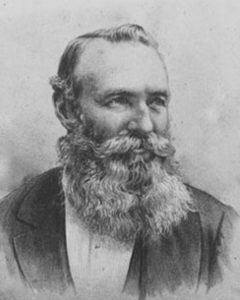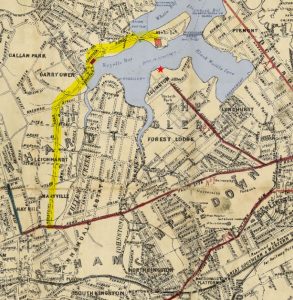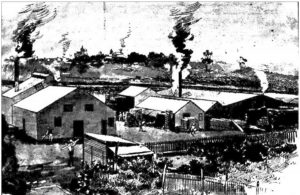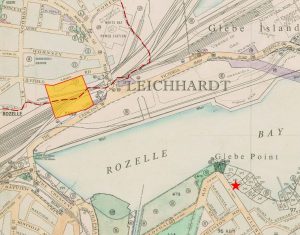By Rodney Hammett, Bulletin 4/2022, June 2022
A recent enquiry to The Glebe Society website asked: ‘Hello, I am wondering if photos exist of a mansion called Alston on Glebe Point Rd. In researching some family history, I have discovered it was the home of my great-great uncle William Alston Hutchinson who was also at one time the Mayor of Glebe and of Balmain. Thank you.’

I had to reply that we don’t have a photo collection, but there might be a photo in the City of Sydney Archives or at the State Library. I was, however, able to identify where Alston once existed on Glebe Point Rd and that it was a large house with land going down to Rozelle Bay. The site is now part of Pavilions on The Park at 501 Glebe Point Rd (see Figure 2).
The site of Alston comprised lots 40, 41 and 42 of the 1872 subdivision of Mary Chisholm’s land, which the Hutchinson family acquired in 1883-84; the house was constructed in about 1890.1 Immediately prior to that, from 1886, the family had lived just up the road in the northern part of current No 449 Glebe Point Rd. No doubt they took an interest in the building of their new house. (See the red star in Figure 1; see also Bulletin 07/2018 for an article on The Birtles, by Lyn Collingwood, describing other people who bought land in this subdivision.)
So, who was William Alston Hutchinson? The Australian Dictionary of Biography (ADB)2 states:

William Alston Hutchinson (1839-1897), manufacturer, merchant, colliery director and politician, was born on 26 March 1839 at Garrigill, near Alston, Cumberland, England, son of Thomas Hutchinson, store-keeper, and his wife Jane, née Phillipson. He was educated at Alston Grammar School and in 1857 arrived at Melbourne in the Commodore Perry, apparently lured by the goldfields. He went to Castlemaine and Ballarat but turned to trading. In 1860 he visited an uncle in Newcastle, New South Wales, where he set up as a store-keeper. In 1861 he married Barbara Telena, daughter of James Steel, a colliery engineer.
In 1872 Hutchinson moved to Sydney, where, in 1876, he founded a successful soap and candle factory in Abattoir Road, Balmain. In 1878 he was elected an alderman. Described by a local newspaper as a ‘dark horse’, he became mayor in February 1881. He began a vigorous term of office in which the Town Hall buildings were completed, as were other improvements in the council area. In 1883 Hutchinson, aided by the mayor of Sydney, John Harris, formed the Municipal Association, which he hoped would ‘weld together the scattered municipalities of the colony as a whole, with a common interest to strengthen and help each other for their mutual good’. He was the association’s acting secretary and, in 1897, its vice-president.

On 2 December 1882 Hutchinson was elected for Balmain to the Legislative Assembly. As a politician he was earnest if not particularly distinguished; he supported Alexander Stuart’s 1883 crown lands bill and carried two private Acts. As the company’s chairman he had successfully promoted the Redhead Coal-Mine Railway Act of 1883. In 1885 he did not seek re-election, reputedly ‘disgusted by the great waste of time and the heated feelings that so distinguished the Assembly’. In 1884 he set up as a merchant in Bond Street, Sydney, and turned to municipal affairs, serving as alderman of the Glebe for nine years and its mayor in 1896; he was also a justice of the peace. He was a commissioner for New South Wales at the 1886 Colonial and Indian Exhibition in London and at the 1893 World’s Columbian Exposition in Chicago. He later developed a wide range of business interests and became a director of several companies and managing director of the Hetton Colliery. He was keenly interested in the building society movement and a director of the New South Wales Institution for the Deaf and Dumb and the Blind. He died at his home, Alston, Glebe Road, on 20 June 1897 and was buried in the Anglican section of Waverley cemetery. He was survived by his wife and by three sons and five daughters of their eleven children. His probate was sworn at £36,000.
Further Trove and land titles research revealed more of the family’s story, some of which differs from that in the ADB. William paid the deposit for his parents Thomas and Jane, and eight siblings to immigrate to New South Wales. They arrived in Sydney on the Ocean Monarch in September 1862. Sadly, the youngest, Anne, who was only a few months old when they left Liverpool, died at sea a week out of Sydney.3 The family continued with the ship to Newcastle, where it off-loaded two locomotives and a steam crane that the Government had ordered.4 William’s father, Thomas, originally a tin miner and later a grocer, soon joined William in establishing a grocer shop in Newcastle –William did not join an uncle in Newcastle, as stated in the ADB.
While earning a living as a grocer in the Wickham area of Newcastle, William had, by 1869, also established a soap works ‘Hutchinson’s Soap Works’.5 With his neighbours, William had started lobbying for improved roads and amenities in Wickham. When Wickham was proclaimed a Municipality on 27 February 1871, W. A. Hutchinson was appointed as the Council Clerk, a role he undertook efficiently. William ceased earning a living as a grocer at about this time.
In 1872 William also found time to undertake the role of Secretary for the Newcastle Gold Mining Company. The company had purchased a 10-acre lease at Golden Gully, Hill End; however, this led to naught. In July 1872, William and Charles Upfold entered into a partnership at Wickham as Soap and Candle Manufacturers, using the name Hutchinson and Upton. This partnership was dissolved by the time William established his Alston Soap Works. Charles Upton continued soap making, and in 1892, he had the Upton Marvel Soap Works in Ross St, Forest Lodge.6

William resigned from his Council Clerk position in 1874 (not 1872), moving to Balmain where he established the Alston Soap Works on Abattoir Rd (see Figures 3 and 4). The family lived at the works, and in May 1875, their eighth child, son William Alston, was born here. Tragically, in 1877, little William, a toddler, drowned in a well under construction in their backyard.7 Two further children (Lillian b. 1877 and Thomas b. 1880) were born at the Alston works, and their last child, Phillis, was born in Glebe in 1886.
Figure 3 shows the route of Abattoir Rd (highlighted in yellow), which is now Catherine St, Leichhardt and Lilyfield Rd, Lilyfield. The site of the Alston Soap Works is marked in red, and the abattoirs are marked in pink (at the end of Abattoir Rd). Alston House at Glebe Point is marked with a red star. The extent of Rozelle Bay and the Harbour in the 1880s is clearly seen in blue.
Following Hutchinson’s death in June 1897, Barbara and the family continued living at Alston House, where they enjoyed the many social occasions in Glebe and Sydney, their names often appearing in the social columns of the day. 1907 saw their relocation to Wycombe Rd, Neutral Bay, and, in 1915, Barbara moved to Coolong Rd, Vaucluse, where the house was named Alston. Barbara died in May 1920, aged 76 and is buried in Waverley Cemetery with William and her parents.

Figure 5 shows the approximate location of the Alston Soap Works on a 1971 map with the original shoreline marked in a dashed brown line.8 This is before the City West Link was constructed and shows the railway lines that have now been removed as part of the M4-M5 Link Rozelle Interchange. The railway land at the left is expected to be turned into parklands. Alston House at Glebe Point is shown with a red star.
Footnotes: 1. NSW Land Registry Services; Vol 1048 Fol. 135 and Sands Directory; 2. Harry Harper, ‘Hutchinson, William Alston (1839-1897)’, Australian Dictionary of Biography, National Centre of Biography, Australian National University, https://adb.anu.edu.au/biography/hutchinson-william-alston-3830/text6079, published first in hardcopy 1972, accessed online 4 November 2021; 3. Ancestry; NSW Passenger Lists; 4. Trove: Maitland Mercury, 15 November 1862, p7; 5. Trove: Newcastle Chronicle; Thu 7 October 1869, p.2, and Maitland Mercury; Tue 27 April 1869, p.2: ‘The Late Agricultural Show’; 6. Referenced in Max Solling’s article in Bulletin 03/1991; 7. Trove: Newcastle Morning Herald, Thu 10 May 1877, p2; 8. NSW Land Registry Services; Vol 1020 Fol. 48;

Posted on 7 June 2022 by Rodney Hammett
For more information email: heritage@glebesociety.org.au








There are no comments yet. Please leave yours.